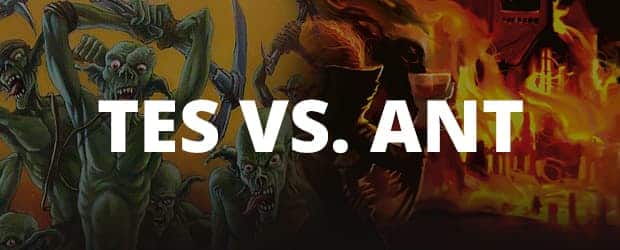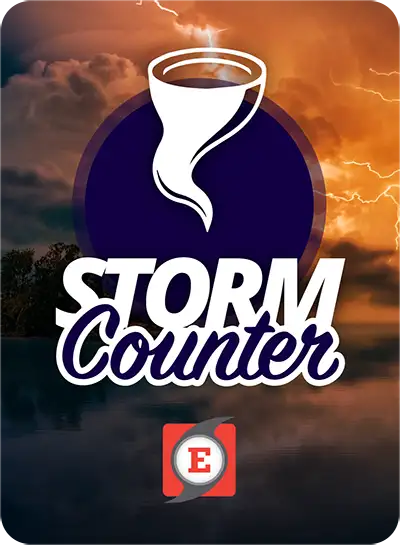I read a lot of discussions around the internet and through coverage, people don't really seem to understand the differences between The EPIC Storm
(TES) and
Ad Nauseam Tendrils
(ANT). Not only the card differences, but how they actually play differently and how the different versions have unique strengths. Let's start with the basics, TES is an
Ad Nauseamand/or
Empty the Warrens based deck while ANT is a
Past in Flames/natural storm
("tutor chain") based deck. TES is designed to actually have better
Ad Nauseam reveals than the namesake deck itself, with copies of
Chrome Mox to help ensure that the deck is able to kill the opponent once the spell is done resolving. The deck actually has a lower average converted mana cost as well, since TES only plays two cards (
Empty the Warrens and
Ad Nauseam) that cost more than two mana
(one of them being on the stack when it's relevant) where ANT due to not having
Burning Wish plays anywhere between three and six cards greater than two mana.
Burning Wish allows you to play some of the expensive mana cost cards while not ruining your Ad Nauseams. A common misconception is that TES doesn't use
Past in Flames or even
Tendrils of Agony, which is sort of ridiculous as both Storm variants kill most of the time with the Scourge uncommon. Not playing
Tendrils of Agony in the main deck isn't a big deal as most of the time that you could play it
(post-Ad Nauseam), you have two additional mana to cast
Burning Wish first. By playing
Burning Wish, you open yourself up to a toolbox that provides the correct cards for the appropriate situations – sometimes this means using
Past in Flames, sometimes is means retrieving
Massacre to devastate your Death & Taxes opponent. Using this red sorcery, you're also able to answer unbeatable cards in game one that would otherwise be impossible such as
Gaddock Teeg or having your
Tendrils of Agony removed by
Deathrite Shaman.
If you're unfamiliar with the decks, there's a few defining feature's of each deck that make them easily recognizable. To people that aren't too familiar with the Storm archetype they would say, "
Cabal Ritual versus
Rite of Flame". Well, they're half right,
Rite of Flame is a feature of TES since the very beginning but both decks have played
Cabal Ritual - I've played it as recently as six months ago. A better card to have mentioned would've been
Chrome Mox, it's a card that has divided the decks for sometime.
Chrome Mox helps power
Ad Nauseam as well as increasing speed the speed of the average
Empty the Warrens. It really helps by allowing a first turn
Ponder or
Brainstorm to find the missing piece, then generating the initial mana source to continue the turn
(While increasing the storm count!).
Burning Wish is the obvious answer, as at this point in time ANT lists no longer play the card – even fringe versions. As mentioned above, TES doesn't play
Tendrils of Agony,
Past in Flames or
Dark Petition (depending on the ANT list) that are all very common cards in ANT. Recently, some ANT lists have cut the
Ad Nauseam from the main deck, but I wouldn't count on that in the middle of a game in order to win.
The decks actually have a very different fundamental turn as well, TES strives to "combo" out on the first or second turn
(sometimes with Empty the Warrens) where ANT's fundamental turn has actually slowed down a little recently as they're focusing on grinding the opponent out of resources paired with the lack of
Ad Nauseam in some lists. Bringing the average fundamental turn to turn three or even possible four. The lists do share a significant amount of cards, so I understand why that may be confusing.
Rite of Flame needing one initial mana compared to
Cabal Ritual creates some speed, generating one mana for more mana compared to two mana for one mana in the early game is very relevant. Threshold isn't a quick ability and can often take to the third or fourth turn to set up, it can be set up on the second turn but it's not typical. The additional speed comes from the power of
Chrome Mox (mentioned above) over additional lands. TES plays thirteen main deck lands with an occasional land in the sideboard, where ANT's most successful list
(Scherer's) plays fourteen
(some lists are fifteen) with one in the sideboard. The difference in one land to possibly two is almost not recognizable where the increased quality of
Ad Nauseam and
Empty the Warrens definitely is.
There's a preconceived notion that TES's mana base is "unstable" which has been carried over from the days
(roughly two years ago) when TES played five-color lands over additional copies of fetchlands, which just isn't the case. TES plays a basic
Swamp that can be found with both
Bloodstained Mire and
Polluted Delta to allow a first turn discard spell
(Both decks traditionally play seven discard spells), into a second turn combo without being disrupted by
Wasteland. TES does not play a basic Island, which is something ANT does, which is often looked at in ANT's favor - but it just doesn't make sense for TES.
Brainstorm and
Ponder are the only cards that require blue mana in TES where ANT also has some number of
Preordain, not to mention that TES regularly sides out
Ponder meaning that the deck would be left with anywhere between 4-6 cards that could be cast off of a basic Island, it just doesn't make any sense. Since most ANT lists play two basics, I find it hard to believe that a single basic land, which is rarely used creates,
"This deck is weak to Wasteland." There's also a fallacy about one deck being two colors while the other is three, considering that ANT's primary focus is
Past in Flames that I find somewhat laughable - they're both 2.5 to 3 color decks depending on the hand.
The difference in threat density between these to decks is a real thing, let's look at the lists above. Due to ANT lists not being clearly defined, there's some room for debate here. However, out of the cards listed there's typically room for a maximum of eight. While ten threats against eight doesn't seem like a huge difference, it actually is when outside of
Infernal Tutor they're all not very mana efficient and some don't play well with others. For example, if playing
Dark Petition, you're most not likely playing
Ad Nauseam. Lists with
Ad Nauseam typically play
Preordain or
Sensei's Divining Top which are slow cards that don't help your problem with threat density or speed. Some lists that play no
Ad Nauseam play an
Empty the Warrens to help in faster match-ups but it usually means one less
Past in Flames or
Dark Petition – there's a lot of sacrifices happening while TES doesn't have this problem.
The decks are similar in the ratio to which they use cards, which is perfectly acceptable. Both decks share enough cards where this isn't very shocking, but I think that ANT really loses out on not using
Empty the Warrens to it's fullest potential. It provides plenty of "free" wins against tempo decks by being cast early when they're not prepared on top of the fact that those decks have a tough time answering hordes of creatures.
Empty the Warrens also has incredible synergy when paired with
Cabal Therapy – shredding the opponents hand and more specifically, whatever they had to answer the Goblins. For this reason, TES runs four
Cabal Therapy and three
Duress while most ANT lists run the inverse of this.
Running
Empty the Warrens helps a lot with the strategy of
"win before the hate comes down" against decks like Death & Taxes, MUD, Elves and even cards like
Meddling Mage,
Ethersworn Canonist and
Counterbalance. The card is even more helpful when it comes to not being graveyard or life dependent to help play around
Deathrite Shaman, which is a huge concern for ANT.
The metagame is shifting away from the "grindy" strategies and more towards faster decks with a quicker fundamental turn. Grixis Delver is the premier tempo deck of the moment, it has
Deathrite Shaman with
Cabal Therapy post-board. Natural storm is very tough against discard as you don't have time to sculpt a hand to make this happen and
Past in Flames is difficult against
Deathrite Shaman. I don't believe that ANT is in a strong place in this match-up where it's much better for TES as their clock isn't as aggressive and they lack the mana denial of other tempo strategies. Against Omnitell, I can't imagine that being slower, needing to build up resources for threshold and
Past in Flames is where anyone wants to be against a deck that can also kill turns two or three that has Force of Will.
These things said, there's room for more than one storm deck in the format – they can co-exist. The both have their place in the metagame but TES is definitely better positioned at the moment in comparison to ANT. These things said, the decks are not wildly different, they're both strong choices and are capable of doing the other deck's strength. TES can win the long game and ANT can kill on turn one, you're really just hedging percentage points from the decks around you for the best possible chance of winning. I hope this was informative and that it creates more open mindedness to try TES.
Until next time, keep storming!














